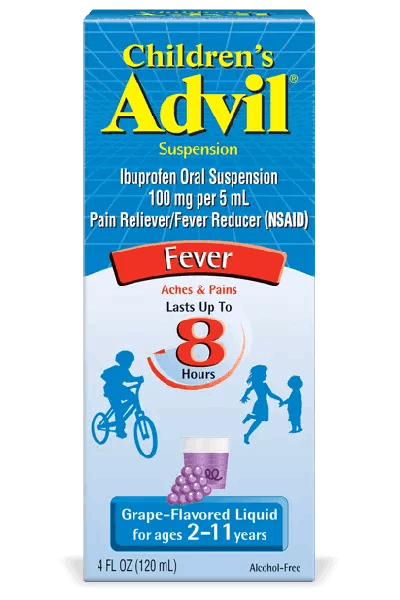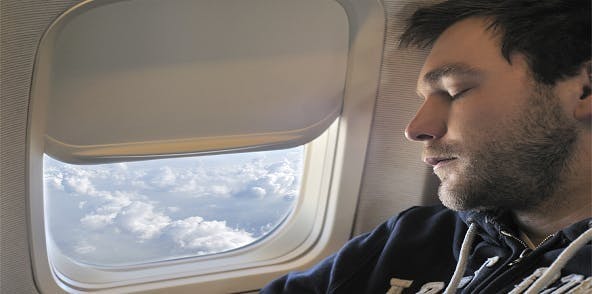The Painful Sleeplessness Of Jet Lag
You’re at the end of a long journey. You’re finally at the place you wanted to be, but you’re exhausted, tired and wound up at the same time. You’re disoriented, wondering, should I eat or sleep, maybe go for a walk? It’s tough to think clearly, your mind feels addled and awash in fog. Your body also aches, your head hurts, and that sore knee you do your best to ignore at home is now throbbing.
"Jet lag isn’t only tiring—it can often be painful"
What is jet lag, exactly? Anyone who’s traveled through time zones knows what it feels like—the sluggishness and fatigue, the foggy-headedness, the dizziness and disorientation. You’re overtired and unable to sleep—or very tempted to sleep at the “wrong” time. But what causes jet lag? To understand jet lag and its effects on sleep and pain, it’s helpful to first understand the basics about the body’s circadian rhythms.
Circadian rhythms are the body’s biological alignment with the 24-hour cycle of light and dark. Sleep and wakefulness are governed by circadian rhythms, as are many other of the body’s biological processes. When circadian rhythms are in sync, aligned with the solar day and night, sleep can be routine, and restorative. Traveling far enough that you’ve entered a different cycle of light and darkness upsets the body’s circadian rhythms, causing sleep problems and other symptoms of jet lag. Jet lag is most often caused by travel, but the circadian disruptions that cause jet lag can occur in other situations, such as shift work that exposes people to different or irregular cycles of sleep and wakefulness that are out of sync with their solar night and day.
In addition to tiredness, fatigue, and confusion, jet lag can also be accompanied by headache, nausea, and body aches. Pain and discomfort associated with jet lag may be the result of the uncomfortable realities of extended travel—cramped and uncomfortable seats, long periods of time without moving much, changes in air pressure and altitude. Or you may have pain and discomfort—a chronically bad knee, a pulled shoulder muscle, a lingering cold with headaches and muscle aches—that existed before you stepped on the plane.
Whatever the source of pain, the physiological impact of jet lag can make pain more difficult. Because of the complex relationship among sleep, circadian rhythms, and pain, the disruption of jet lag can exacerbate pain, slow healing and recovery, and extend sleep disruption.
Sleep and pain exist in a bi-directional relationship—each has the power to significantly influence the other. The presence of pain makes it harder to sleep the whole night, leading to less sleep overall and to lower quality, less restorative sleep. Poor sleep, in turn, makes pain harder to deal with—it actually lowers pain thresholds and increases sensitivity to pain, as well as making pain harder to treat. A recent National Sleep Foundation survey on the subject of sleep and pain found that a majority of Americans are experiencing either chronic, or recent, acute pain. These people are much more likely to report having sleep problems as well as higher stress—another condition that can significantly impair sleep and worsen pain. Add jet lag into the mix, and the sleep-pain picture gets even more complicated, with sleep disruptions and pain levels likely to increase.
Pain is also influenced directly by circadian rhythms. Studies show that the experience of pain—and the effectiveness of pain treatments—is tied to circadian clocks. Research indicates that for healthy people without specific pain issues, pain sensitivity peaks during nighttime hours—just as you’re trying to sleep. But not all pain follows the same circadian timing. Different forms of pain show different rhythms, and may intensify or lessen at different times of day and night. Arthritis-related pain and stiffness tends to be at its most intense first thing in the morning and at night before bed, with a dip in severity around mid-afternoon, according to research. Tension headaches—a not uncommon occurrence during travel—appear often to be weakest in the morning, and most severe in the afternoon. Other research shows that the effectiveness of pain medications is also influenced by circadian timing.
In addition to pain being aggravated and heightened by sleep loss, pain is also likely to be affected by jet lag’s underlying disruption of circadian rhythms. The ways you experience and manage pain may change as a result of this disruption. So might the way you treat your pain, as medications may not work as they do at home.
There are several lifestyle factors that can influence how severely you experience jet lag, and several of them relate directly to sleep:
Being overtired before you start. If you’re already short on sleep before you board the plane, you’re more likely to feel the physiological effects of jet lag more severely—and to experience greater pain and discomfort.
Drinking alcohol. It may feel like just what you need to relax during a long flight, but alcohol consumption will make any sleep you do get during travel less sound and refreshing, and may contribute to an even greater disruption to your circadian clock.
Stress. Stress and sleep have their own complicated, bi-directional relationship, just like pain and sleep. Stress also exacerbates pain. Travel—particularly long trips with several legs—can be tremendously stressful. It’s important to prepare for your journey in part by bringing along some strategies for managing your stress, whether its meditation, breathing exercises, or relaxing music. You’ll rest better in transit and when you reach your destination.
An irregular, inconsistent sleep schedule. Sleep thrives on routine, which strengthens circadian rhythms. Going to bed and getting up at significantly different times undermines the healthy, normal functioning of the circadian clock, and can make it harder to get the rest you need. If your sleep schedule is catch-as-you-can, spend the few weeks before your trip sleeping on a regular schedule. You’ll catch up on sleep, and give your circadian clock a chance to start functioning in sync.
There are a number of ways you can help alleviate and shorten the effects of jet lag, and any pain you may experience during travel. Some attention and effort in the weeks and days ahead of your trip can make a big difference in how you feel when you’re on the road:
Adjust your sleep schedule. With small, incremental changes to your sleep and wake schedule, you can lessen the impact of time zone changes to your circadian rhythms and your sleep. A week or two before you leave, begin to pull your sleep schedule back (or move it forward), by 10 to 15 minutes a night. Don’t just change your bedtime, change your wake time, too, by the same amount. The goal need not be to adjust all the way to your destination time—though if you’re traveling a shorter distance, that may be feasible—but to give your body a gradual, gentle head start on the time shift that’s upcoming.
Take care of pain issues. Do your best to travel healthy. Whether it’s a cold or flu, a chronic pain issue that you’ve put off dealing with, or an unexpected flare-up of physical pain or discomfort, tend to the issue before you begin your trip. Your body’s defenses will be compromised by the upheaval of jet lag; you can help counteract that vulnerability by taking care of your health and pain problems ahead of time.
Be rested. Starting a trip sleep deprived is only going to make jet lag more severe, and ratchet up whatever pain or discomfort occurs during your travel. Think ahead, several weeks if need be, and make a plan to pay down your sleep debt and catch up on your rest before you hit the road.
Schedule with sleep in mind. It may be tempting to book the quickest, cheapest itinerary to wherever you’re headed, but this approach can leave you with more serious jet lag than if you create a more sleep-friendly travel schedule. Whether you’re flying or driving, look for ways to break up your travel to allow you to rest, and incrementally adjust to the time changes you’re experiencing.
Dress comfortably. You’ll rest better on the journey if you’re in comfortable clothes. Avoid clothes that are constricting, and synthetic fabrics that don’t breathe. Loose clothes in natural fabrics like cotton or linen work best.
Keep in mind: these strategies and guidelines apply to people who travel regularly just as they do to people who venture far from home very occasionally. Understanding how sleep, pain, and jet leg influence one another can help you minimize your jet lag symptoms, and have a better, healthier, more restful journey, whether it’s a routine trip for work or a long-planned vacation.
Sweet Dreams,
Michael J. Breus, PhD
The Sleep Doctor™
By clicking the link(s) above, you will be taken to an external website that is independently operated and not managed by Haleon. Haleon assumes no responsibility for the content on the website. If you do not wish to leave this website, do not click on the links above.








